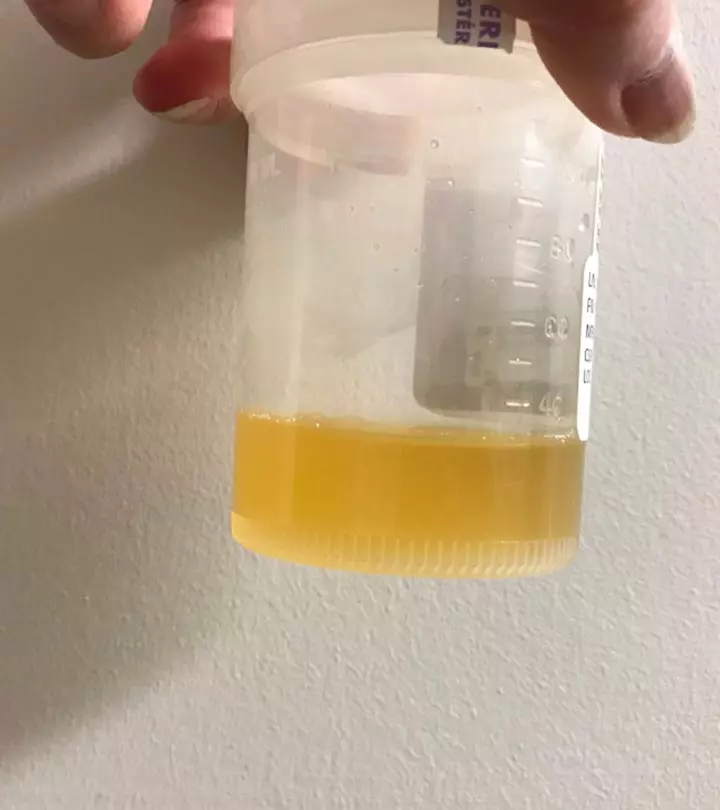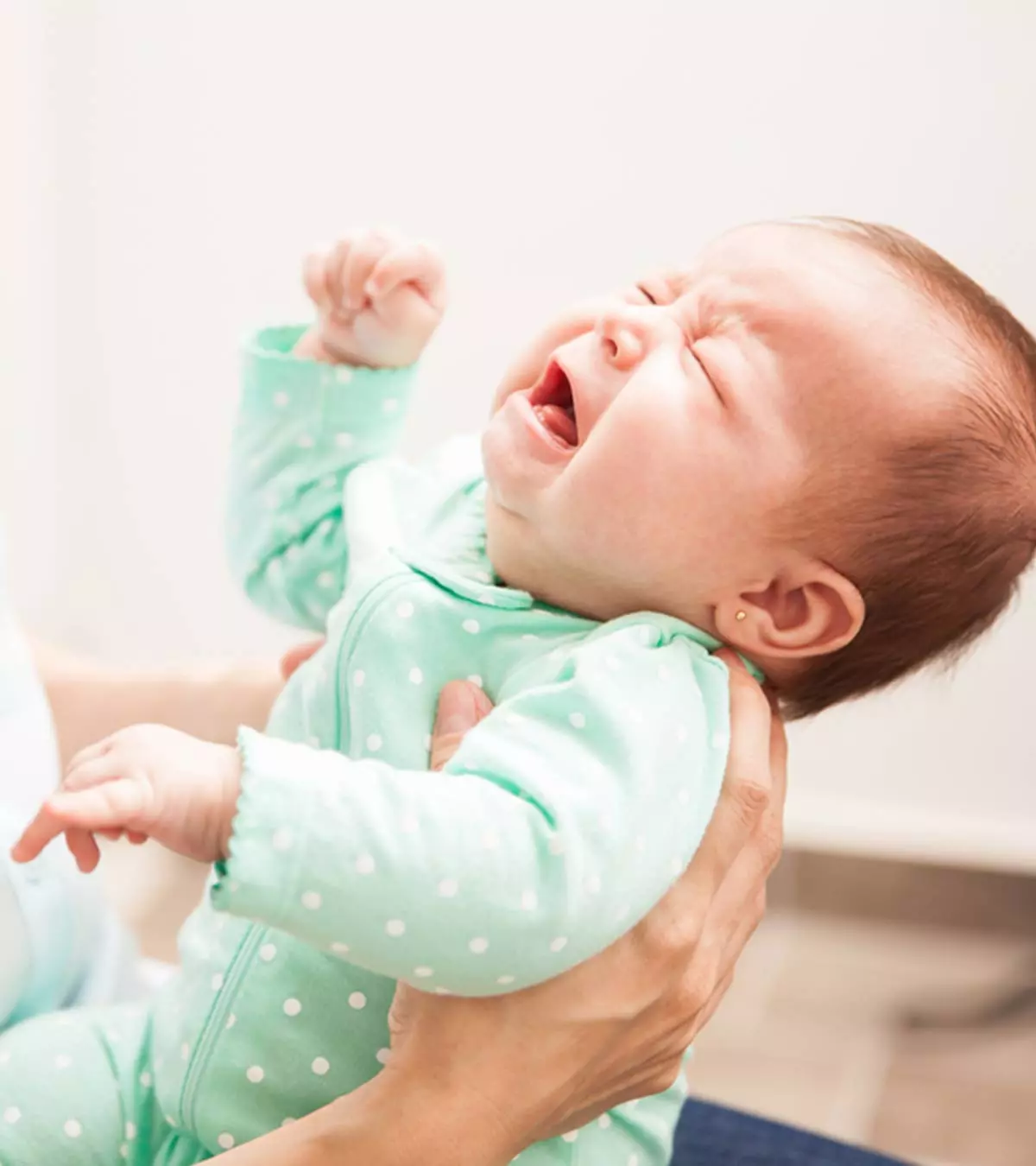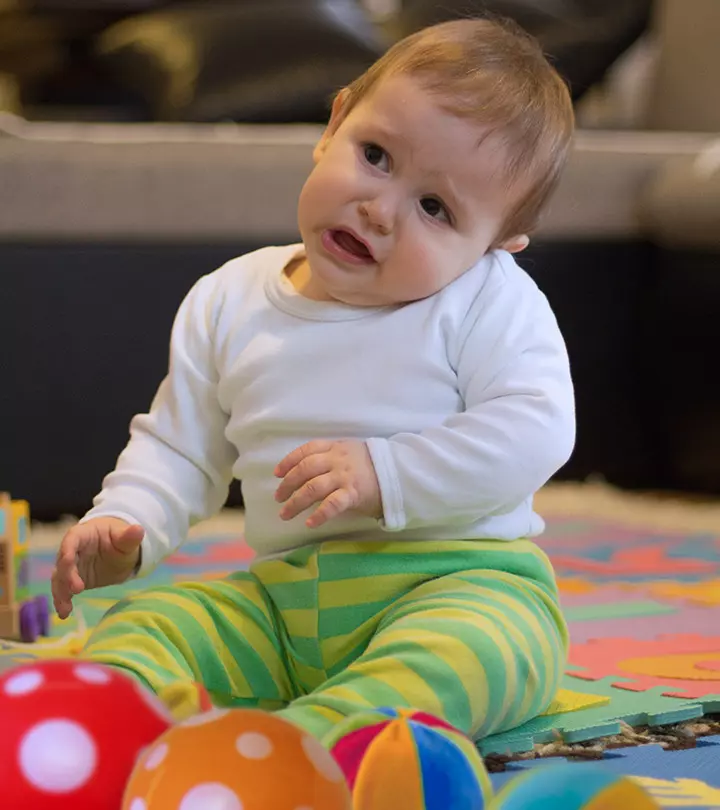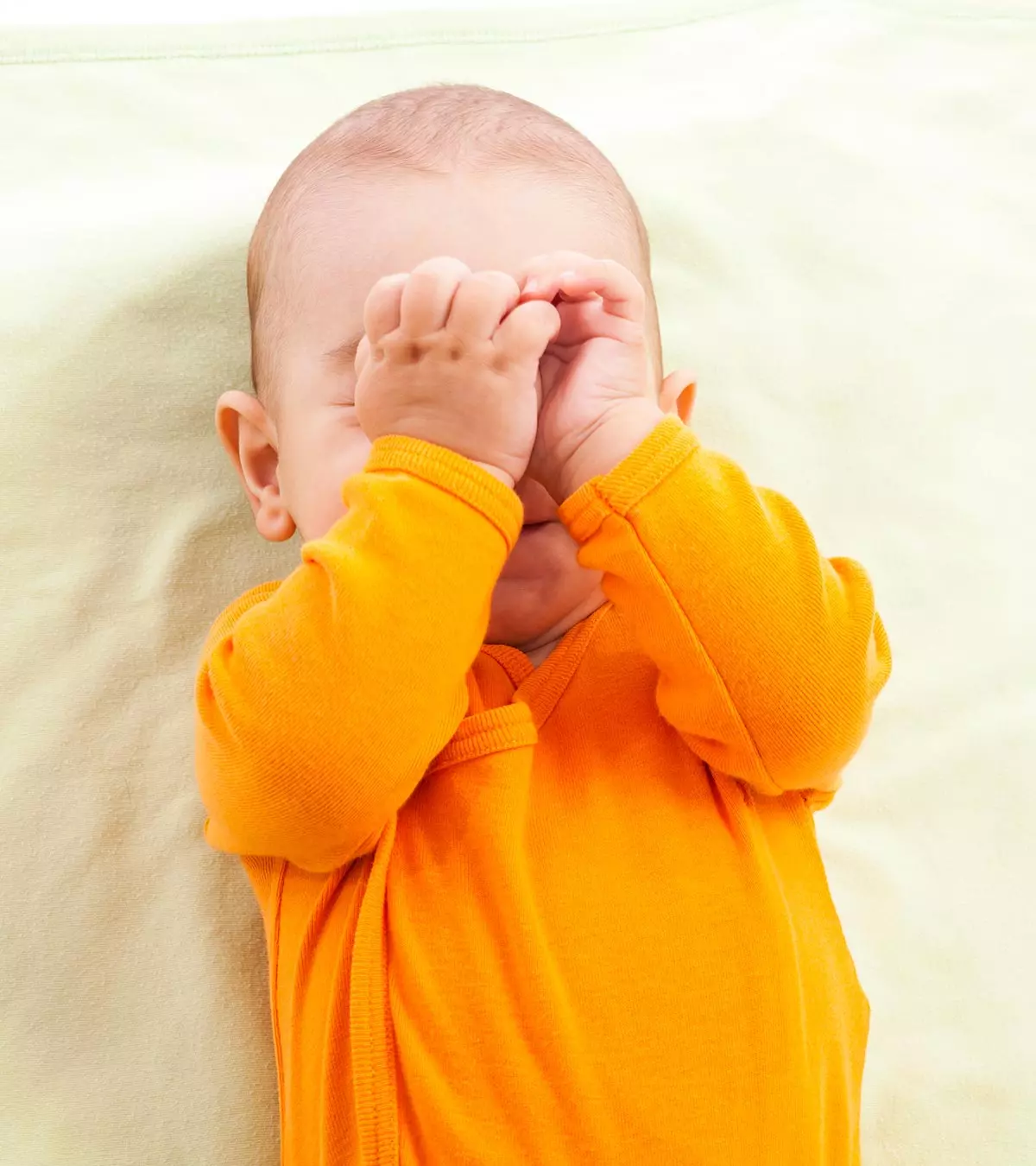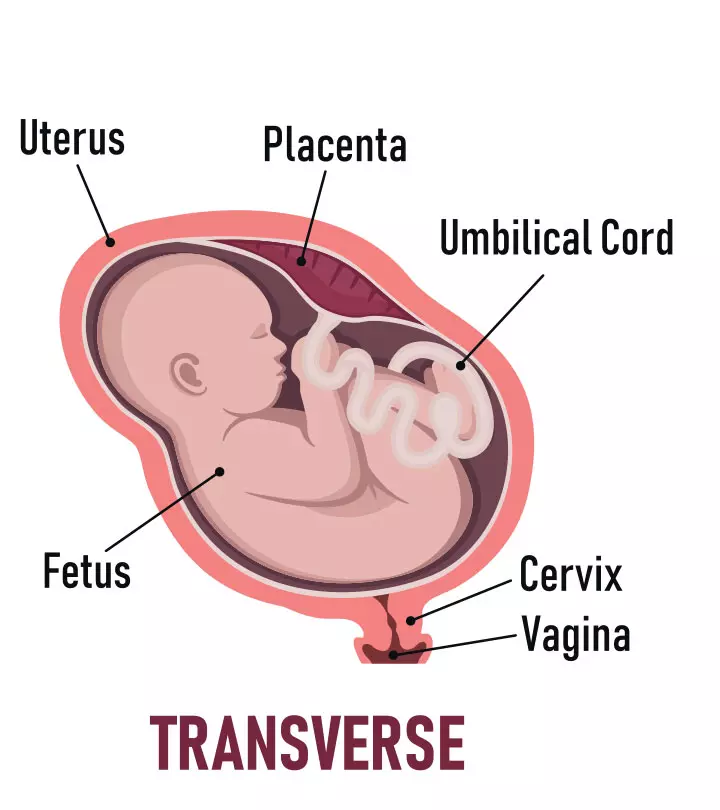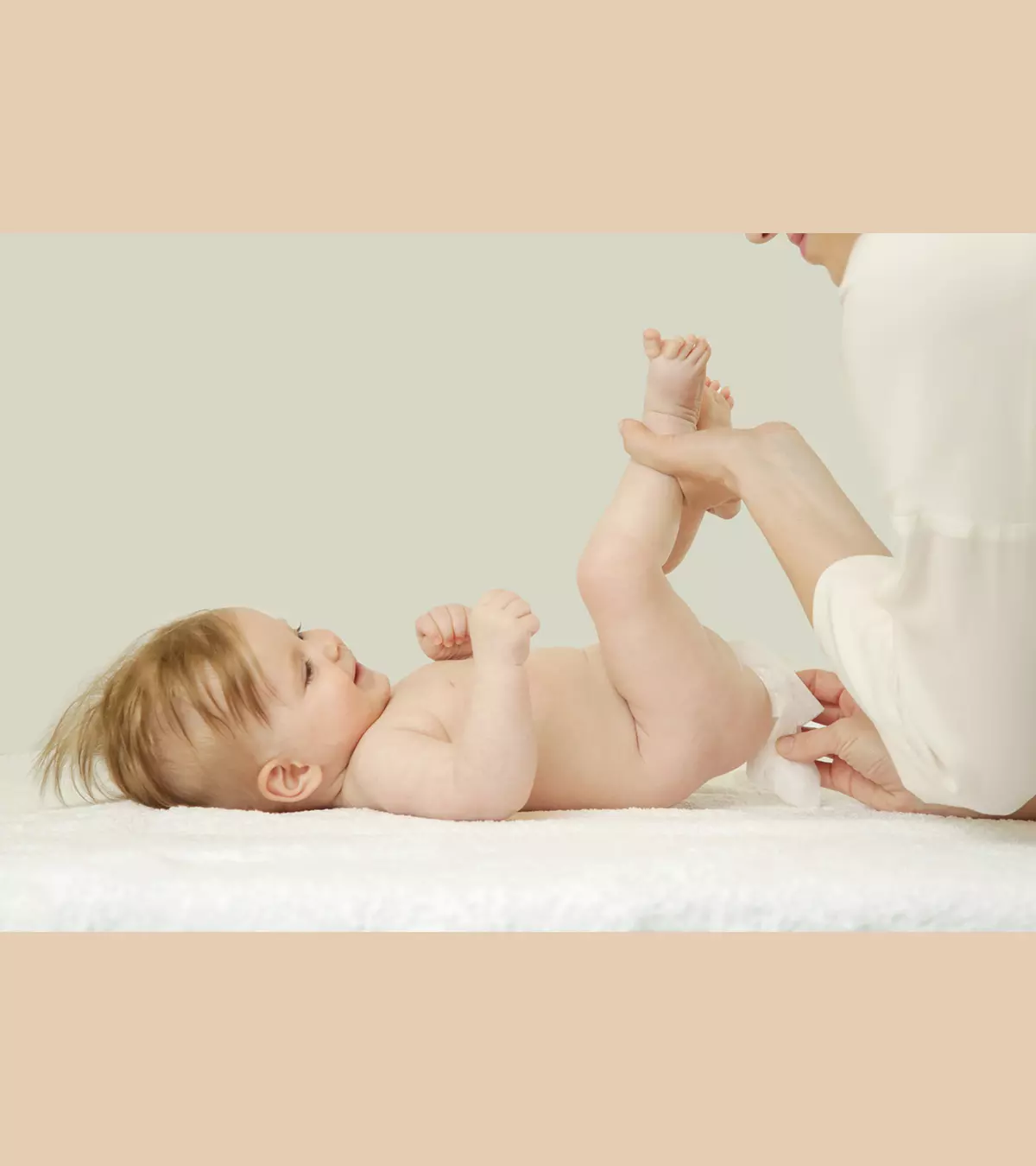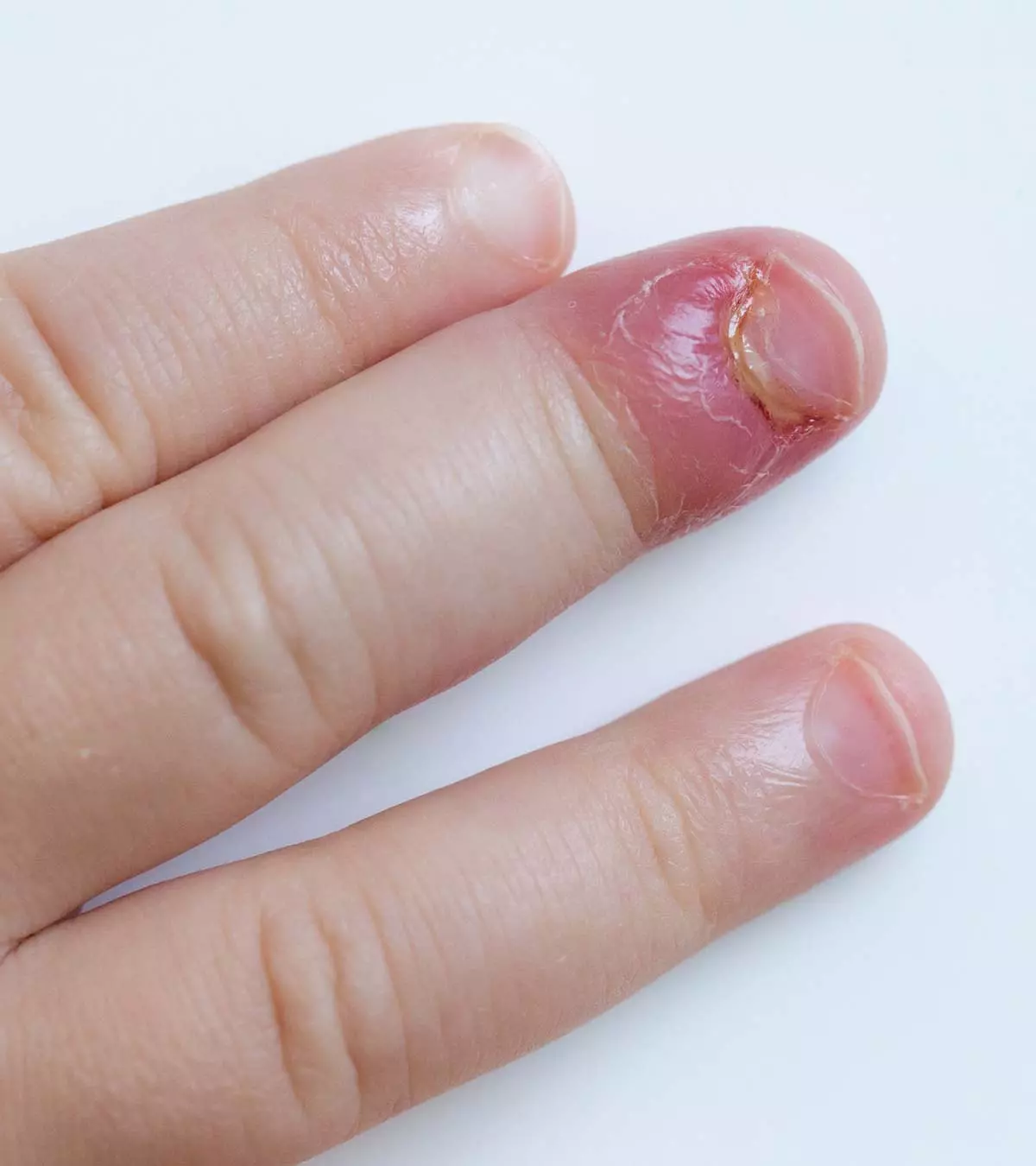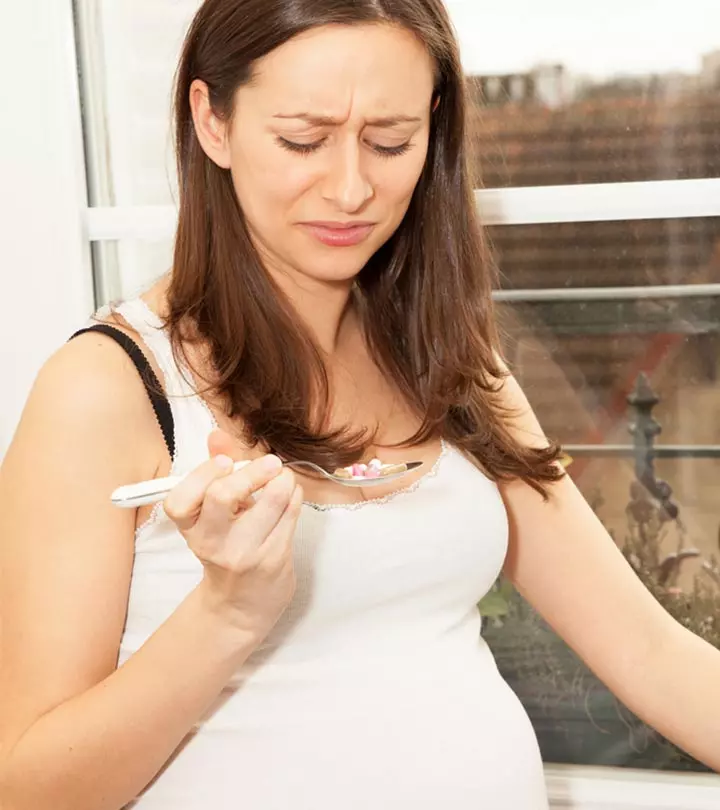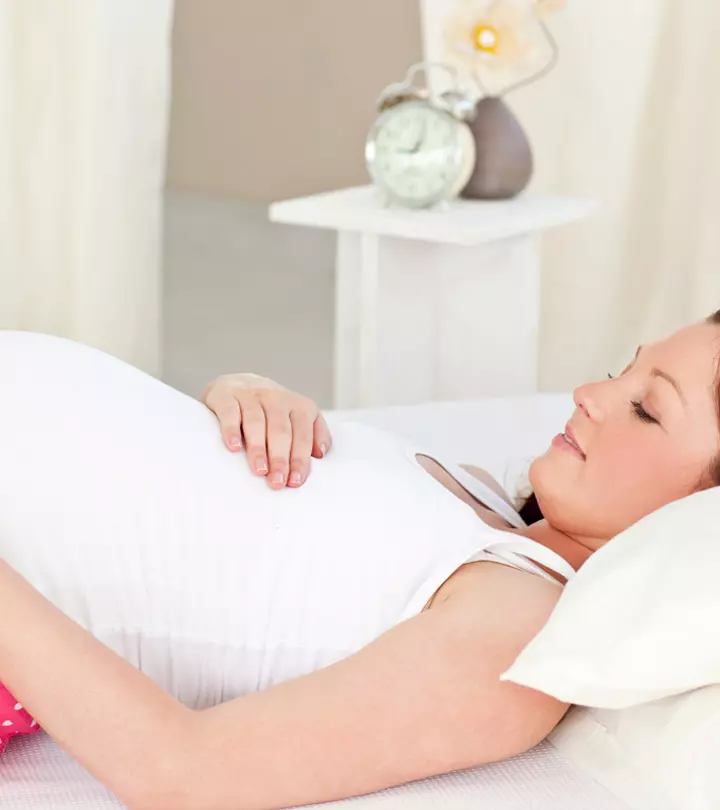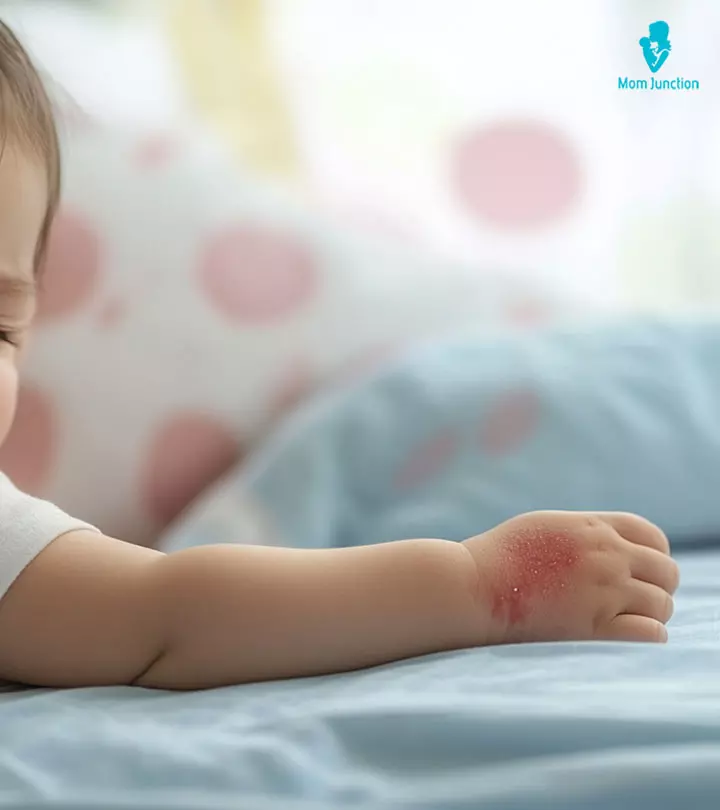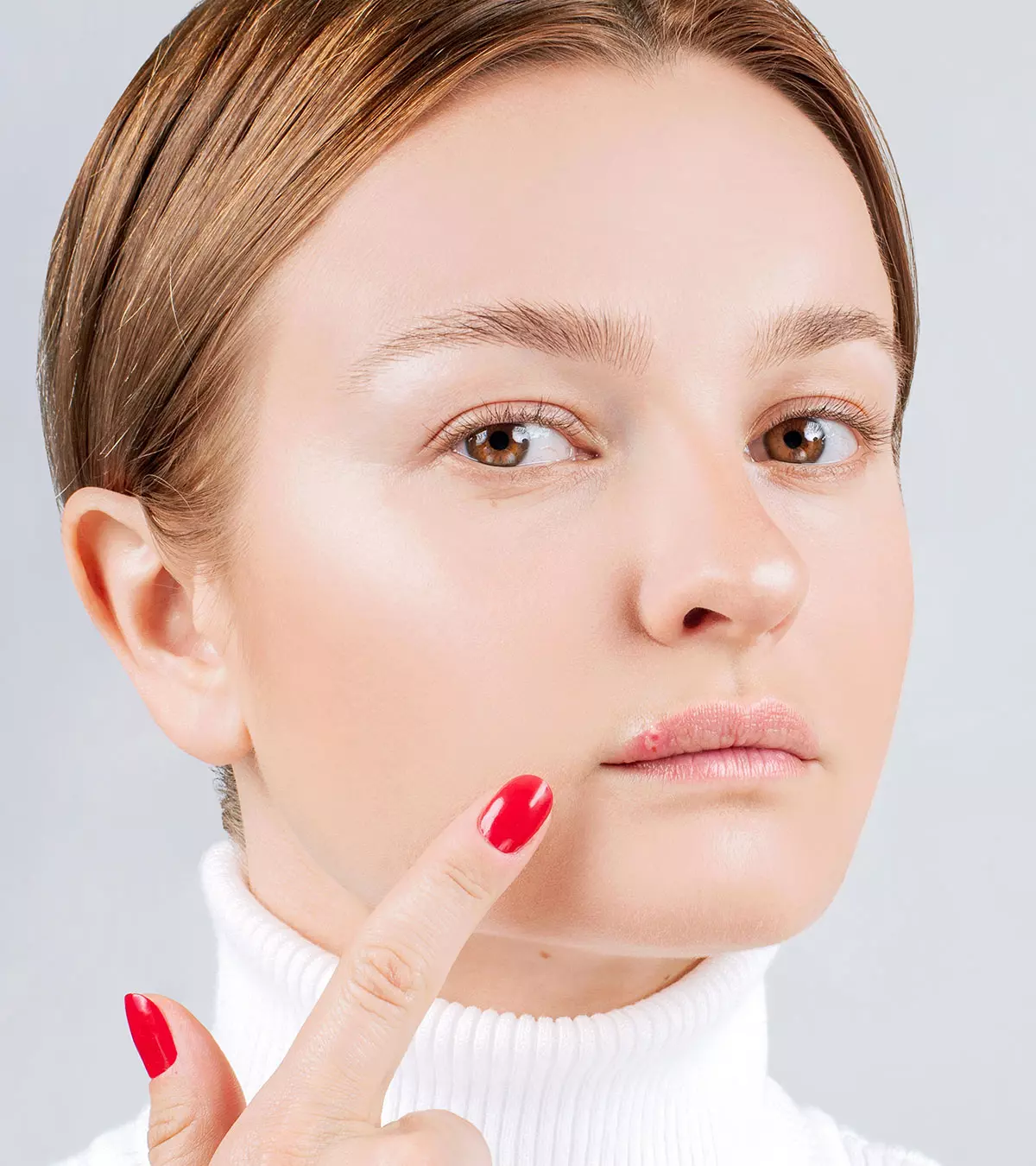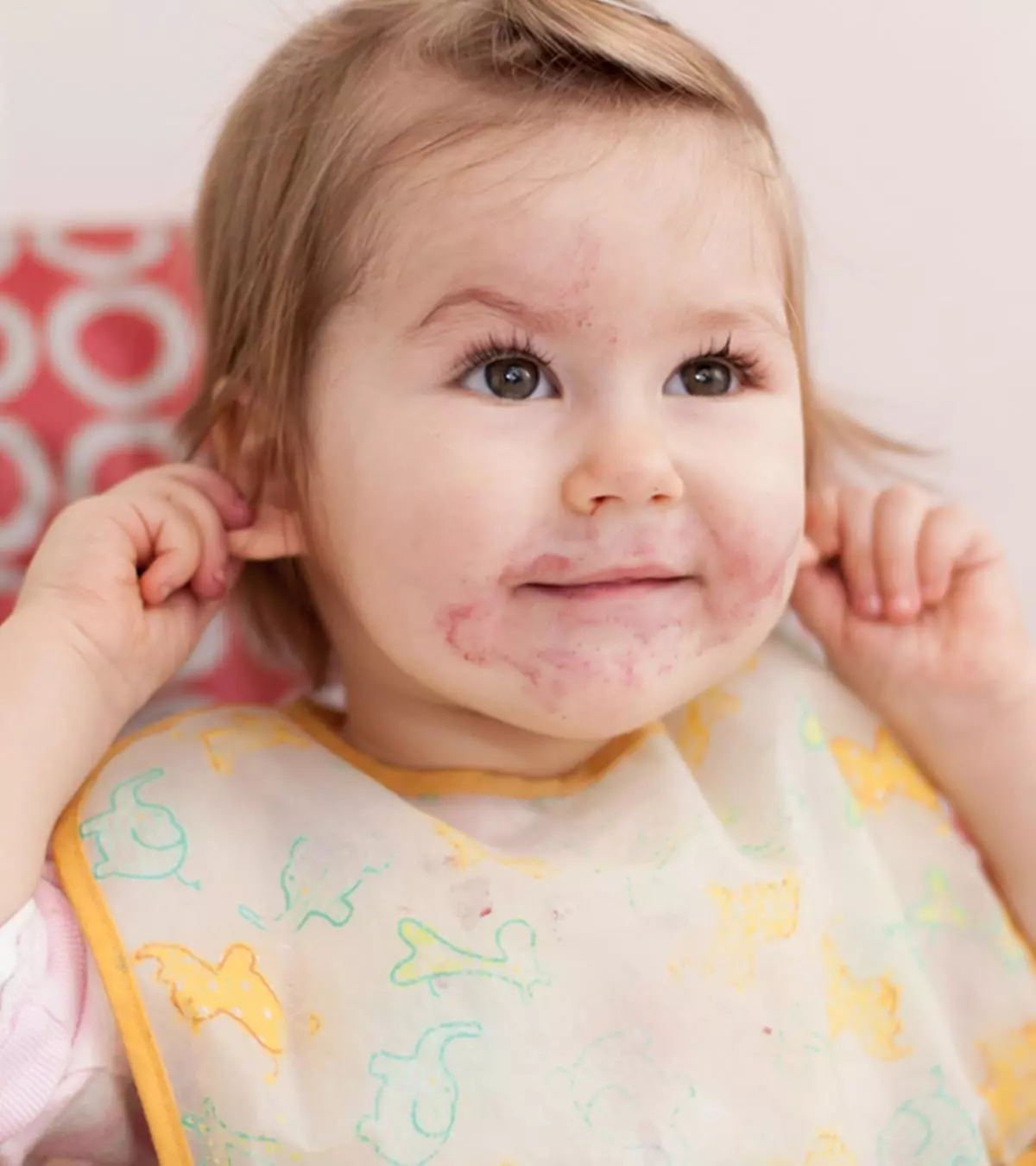
Image: shutterstock
Babies are eager to discover all the new attributes of their surroundings and bodies. As a result, it is not uncommon to see babies pulling their ears when they realize those flappy protrusions on the sides of their heads can be pulled. While most reasons that cause babies to pull their ears are harmless, this behavior may also be due to serious underlying conditions such as allergies or infections. Knowing these reasons helps parents distinguish between normal behavior and potential health concerns.

Keep reading this post to learn more about why babies pull their ears, how to deal with this behavior, and when to be concerned about it.
Key Pointers
- Self-soothing or discomfort due to ear infections may be common reasons babies pull their ears.
- If you notice fluid oozing from their ears or redness around the ears, consult your doctor.
- Ear pulling may be treated with antibiotics, topical ointments, or the removal of foreign bodies from the ear.
Why Does Your Baby Pull Their Ears?
Below are some of the possible reasons for a baby pulling ears.
1. Play and self-soothing
Most infants may pull their ears while playing or when they discover their body parts. For instance, a baby may pull their ears while also pulling their nose or toes since they may discover these body parts and their range of motion. It is part of the baby’s self-play during their early months.
Babies may also pull their ears as a soothing mechanism. In such cases, you may see the baby pulling their ears when upset, cranky, or when trying to fall asleep. Pulling ears for play and self-soothing tends to begin after the age of four months and stops by 12 months (1).
 Quick fact
Quick fact2. Ear infections and irritation
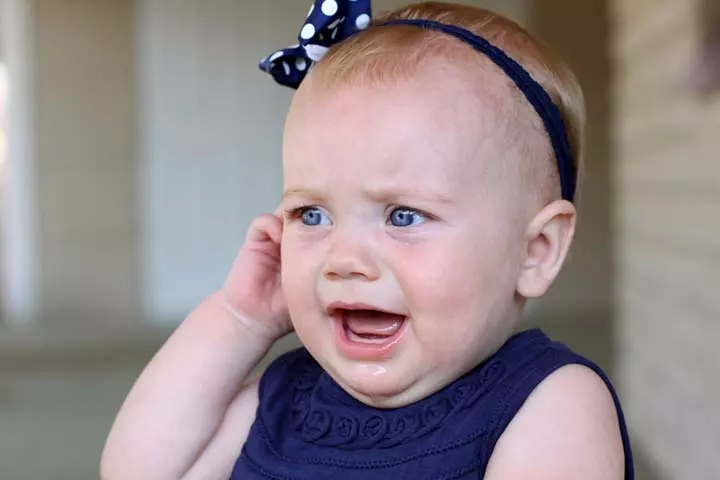
Ear infections cause symptoms, such as ear pain, itching within the ear canal, and a sense of fullness inside the ear, causing the baby to pull their ears.
There are several types of ear infections. Below are some of the common ear infections that could cause a baby to pull their ears.
- Otitis media: It is a common ear infection in babies, and nearly 80% of babies experience at least one otitis media infection by the age of three years (2). There are various types of otitis media infections, leading to different symptoms, which all can lead to ear-pulling behavior. The most common causes are bacterial and viral infections of the middle ear, which lie behind the eardrum. Studies on the pediatric population also indicate a relationship between otitis media with effusion (OME) and infantile gastroesophageal reflux (GER). GER in babies causes stomach acid and pepsin to travel up the immature nasopharynx into the middle ear, causing a condition called glue eariA condition in which a thick sticky fluid builds up in the middle ear and doesn't drain away causing a sense of fullness and discomfort . This condition may cause the baby to pull their ears as a way to deal with the pain and hearing problems (15) (16) (17).
Alison Scott-Wright, a specialist baby sleep consultant and infant reflux management expert, shares her experience with an undiagnosed GER. She shares how all through infancy the child exhibited problems in speech, motor control, bowel movement, sleep, feeding, weight, hearing, skin, cough, and ear pulling. She writes, “She’s always had very waxy ears and often pokes and pulls at them and rubs her face & eyes.
“The more time I spent observing Sophia, the more I was absolutely certain that here was a child that had experienced severe reflux as a baby, suffered with a cows milk protein allergy and had never grown out of it! The next day we all went to see a pediatric gastroenterologist who after much discussion, 100% concurred with my thoughts and prescribed Sophia Omeprazole and advised to put her dairy & soya free and restrict wheat & gluten in her diet… The excessive wax in the ears builds up as the Eustachian tube gets narrowed due to acid damage and the fluid from the middle ear is unable to drain effectively (i).” - Otitis externa: Otitis externa, also known as swimmer’s ear, is commonly caused by bacterial overgrowth in the outer ear canal. Children who are immunocompromised or more susceptible to infection are at a higher risk for fungal causes (3). It may be visible from the outside as redness of the skin around the ear opening. In severe cases, you may also see white patches and fluid oozing from the ear canal. Inadequate drying of the ear after a bath or swimming increases susceptibility to otitis externa.
- Ear infections with upper respiratory infections: Babies with respiratory infections, such as the common cold, could have a higher risk of developing ear infections. Infected mucus from the nasopharynxiThe upper portion of the throat, behind the nose. may flow to the middle ear through the Eustachian tubei Tubes present on either side of the face connecting the middle ears to the back of the throat and nose. . The fluid doesn’t drain as well in babies and toddlers due to the shorter and horizontal nature of the eustachian tube. This may lead to overgrowth of bacteria in the middle ear. A baby with upper respiratory infections may have a concurrent ear infection, causing them to pull their ears often.
Below are some of the other reasons why a baby may pull their ears.
 Point to consider
Point to consider- Air travel: The pressure change inside an aircraft could cause changes in the pressure within the middle and outer ear. It can lead to temporary ear discomfort, making the baby pull their ears (4).
- Foreign body: In rare cases, a foreign body may get lodged inside the baby’s ears. You may be able to spot the foreign body in the ear canal since often it could be stuck within the outer ear.
- Water: A baby may pull their ears after a bath due to water in their ear canals.
- Allergies: Babies with allergies, especially respiratory allergies, may have excess mucus drain from their Eustachian tube to the middle ear, leading to irritation. In some cases, swollen tissues, such as adenoids, may prevent the draining of the fluid from the middle ear to the nasopharynx, causing a sense of fullness in the ear (5).
3. Skin conditions
Babies with skin problems, such as eczema or psoriasis, may pull their ears to relieve the itch and discomfort caused by these conditions (6) (7). In some cases, the skin inside the ear canal could be affected, causing the baby to pull their ears. If your baby pulls their ears due to skin issues, there are likely to be signs of it on other parts of the body.
4. Teething
Teething babies may commonly show ear-pulling behavior due to the gum irritation radiating across the lower jaw (8). They are also likely to display other signs, such as inflamed gums, excess drooling, desire to bite or gnaw frequently, and general irritation.
Besides these reasons, some babies may have the habit of pulling their ears only when frustrated. In rare cases, a baby may pull ears due to underlying injuries to the facial tissues.
When To See A Doctor?

See a doctor if the baby continues to pull their ears for over a week or if they always cry or appear uncomfortable and in pain while pulling their ears.
You must also see a doctor if the baby displays the following signs and symptoms, along with pulling their ears (12) (18).
- Fever with a temperature higher than 100.4°F (38°C)
- Fluid oozing from the ear
- Redness or white patches along the ear canal
- Redness or swelling in the outer ear
- Excess nasal mucus or drooling from the mouth
- Redness of the skin around the outer ear
- Presence of foreign body inside the ear canal
- Signs of infection, such as vomiting, diarrhea, poor appetite, and poor sleep
- Unusual weakness or crying
How Is Ear Pulling In Babies Treated?

If ear pulling is a sign of an underlying problem, treating the issue can stop the ear-pulling behavior. The following treatments may be considered depending on the underlying cause.
- Antibiotics and antifungals: If the cause is an ear infection, and it doesn’t resolve after watchful waiting, the doctor may prescribe antibiotics or antifungals. Oral antibiotics along with antibiotic ear drops could be prescribed in severe cases. Antifungal ointments and ear drops could be prescribed to control the spread of infection in the case of swimmer’s ears.
- Medications for respiratory infections: Upper respiratory infections, such as common cold in babies, can be managed with acetaminophen or ibuprofen prescribed by the doctor. It may help subdue mucus secretion and prevent exacerbation of ear irritation. Infections due to bacteria could be treated with antibiotics.
- Removal of the foreign body: If ear pulling is due to a foreign body, the doctor may inspect the ear canal and remove the foreign body.
 Caution
Caution- Topical ointments: Babies with eczema or psoriasis could be prescribed corticosteroid-based ointments to control the itching. Your baby’s doctor may also prescribe other lotions or creams based on the extent of the skin problem, its type, and its severity.
Most cases of ear pulling in babies can be managed at home with positive results.
How To Manage Baby’s Ear-Pulling Behavior At Home?
Parents may try the following interventions to manage the ear-pulling behavior and prevent the serious causes behind ear-pulling behavior in babies.
- Put mittens on the baby’s hands. If the baby pulls their ears out of habit, you may put mittens on their hands. It may help prevent ear-pulling from becoming a habit in the long run.

- Provide the baby alternatives for self-soothing. You may provide the baby with toys or offer them a pacifier. Provide the pacifier once the baby is older than four weeks and breastfeeding is established. Choose a one-piece pacifier, which will not break when placed in the baby’s mouth (9).
 Quick tip
Quick tip- Dry the baby’s ears adequately after a bath. It could help reduce the risk of otitis externa caused by bacterial or fungal infections.
- Do not use cotton swabs to clean a baby’s ears. Ear canals are self-cleaning, and using cotton swabs may push earwax deeper (10). Use a damp cloth to clean the external ear of the baby. If you notice or suspect excess earwax buildup, speak to a doctor about its removal.

- Manage the baby’s skin conditions. Speak to a pediatrician or pediatric dermatologist to learn ways of managing any existing skin issues. Several skin conditions, such as eczemaiA skin disorder causing dryness, itchiness, and inflammation of the skin in response to an allergen or medicine. , are chronic and require long-term management to prevent itching and discomfort.
- Provide the baby with teethers. A teething baby could be provided with teethers, which the little one can gnaw during the teething phase. Pick one-piece teethers made from non-toxic materials.
- Use a cool-mist humidifier. Humidifying the ambient air in the baby’s room can make it easier for them to breathe and have a calming effect. It could be especially helpful for babies with upper respiratory infections or allergies. The decline in irritation while breathing could reduce the chances of the baby pulling their ears.
- Do not let the baby sleep with a bottle in their mouth. It could increase the risk of the liquid or milk flowing into the nasopharynx, reaching the middle ear through the Eustachian tube. Accumulated milk or other fluids in the middle ear could increase the risk of bacterial infections (11).
- Maintain good hygiene. Good hygiene reduces the risk of several infections, including ear infections. Wash your hands before handling the baby and their personal belongings. Instruct the baby’s sibling to do the same. Wash the baby’s hands after being outdoors, avoid exposure to dust and secondhand smoke, and disinfect their toys periodically with a baby-safe cleaner.
- Get the baby vaccinated. Vaccination against flu and pneumonia could help protect the baby against these infections, preventing the symptoms that often cause a baby to pull their ears.
Frequently Asked Questions
1. Is there a link between ear pulling and colic in babies?
No evidence suggests a link between ear-pulling and colic in babies. Colic symptoms include frowning, grimacing, leg pulling, screaming, and tummy rumblings (13).
2. Can ear pulling in babies indicate a developmental delay?
Ear pulling in babies does not always indicate developmental delay. Still, it can signal an ear infection that, if left untreated, may increase the risk of speech and language developmental delays. Parents must recognize the symptoms of ear infections in babies and seek medical attention when necessary (14).
Babies pulling ears can be a part of the play when they discover two protrusions on the side of the heads can be pulled, or it may occur due to allergies or infections. You may look for the accompanying signs and symptoms to identify the cause. Some babies may experience ear pain and irritation due to ear infections, thus resorting to ear pulling and rubbing. Fever, fluid from the ears, redness, swelling, crying, and fussiness are common symptoms of ear infections and allergies. You may provide some toys or pacifiers for babies to soothe. Ear infections should be evaluated and treated with antibiotics or other appropriate medication as per pediatricians’ prescription.
Infographic: Ear Rubbing In Babies: Less Serious Reasons To Know
When accompanied by other symptoms, ear pulling or rubbing in babies could indicate ear infections or other problems. Nevertheless, sometimes babies may resort to rubbing or pulling their ears for not-so-severe reasons. This infographic will help you understand the less severe causes that could lead to ear rubbing or pulling in babies.
Some thing wrong with infographic shortcode. please verify shortcode syntax
Illustration: Babies Pulling Ears: Top Reasons Treatment & When To Worry
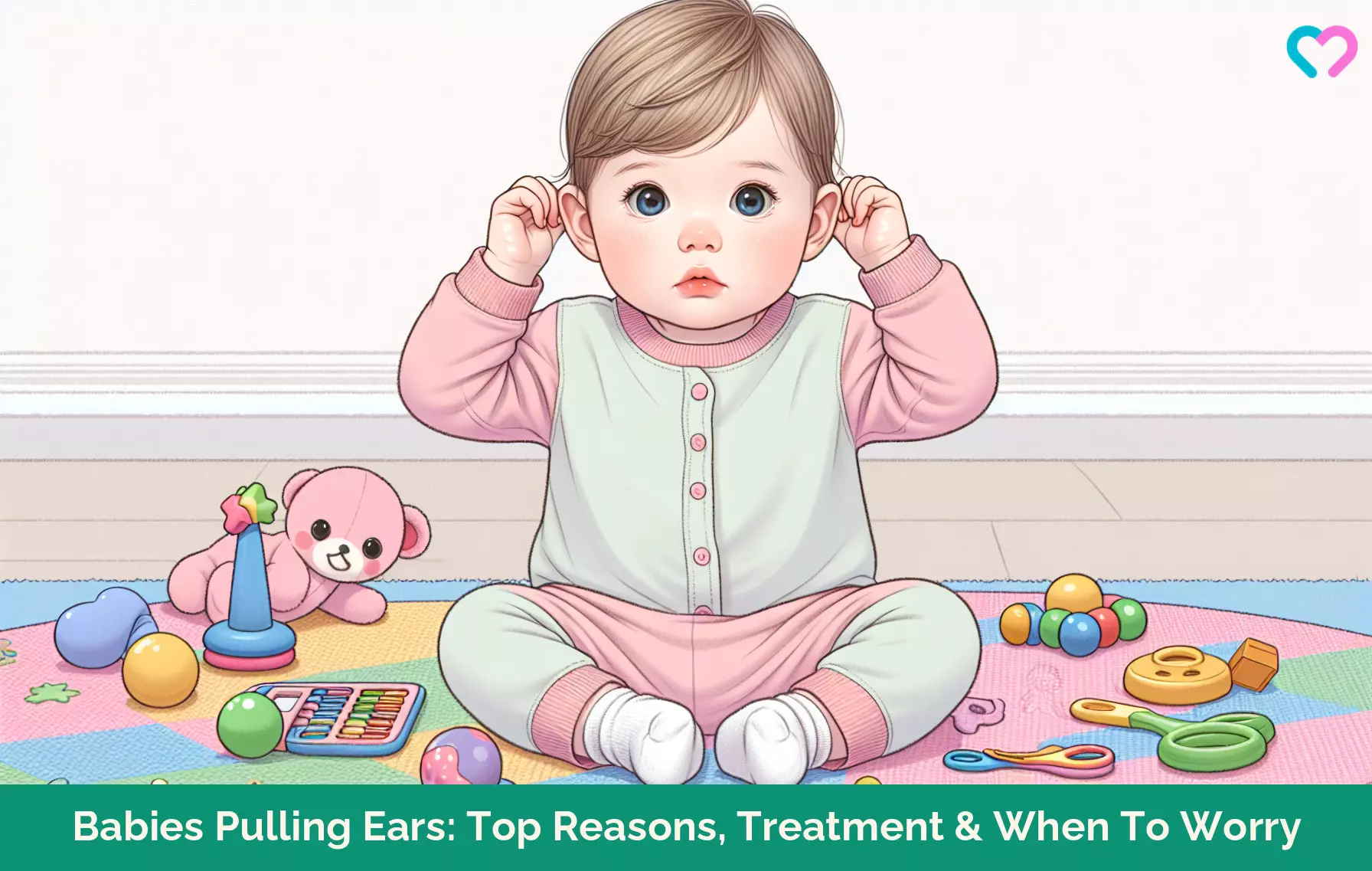
Image: Stable Diffusion/MomJunction Design Team
Watch this video to learn reasons why babies pull at their ears, how to spot them, and ways to assist your little one.
Personal Experience: Source
MomJunction articles include first-hand experiences to provide you with better insights through real-life narratives. Here are the sources of personal accounts referenced in this article.
i. It’s Just a Bit of Colic, They Said — She Will Grow Out of It.https://magicsleepfairy.medium.com/its-just-a-bit-of-colic-they-said-she-will-grow-out-of-it-4c18b1bb7b32
References
1. Ear pulling or rubbing; American Academy of Pediatrics
2. Otitis Media (Middle Ear Infection); Children’s Hospital of Philadelphia
3. Swimmer’s Ear in Children; American Academy of Pediatrics
4. Flying with Baby: Parent FAQs; American Academy of Pediatrics
5. Ear Infection (Otitis Media); Cleveland Clinic
6. Eczema; Harvard Medical School
7. A deeper look at psoriasis; Harvard Medical School
8. Your Infant is Teething; Children’s Hospital Los Angeles
9. Pacifiers and Thumb Sucking; American Academy of Pediatrics
10. Earwax buildup; American Academy of Pediatrics
11. Ear Infections in Children; National Institutes of Health
12. Ear tugging; Raising Children Network.
13. Colic; Better Health Channel
14. Have you heard about ear tube surgery and developmental delays?; Penn Highlands Healthcare
15. G Caruso and FM Passali; (2006); ENT manifestations of gastro-oesophageal reflux in children; Acta Otorhinolaryngologica Italica.
16. P.D. Karkos, D. Assimakopoulos, and W.J. Issing; (2004); Pediatric middle ear infections and gastroesophageal reflux; International Journal of Pediatric Otorhinolaryngology
17. Glue ear; Egton Medical Information Systems Limited.
18. Ear – Pulling At or Rubbing; Seattle Children’s Hospital
Community Experiences
Join the conversation and become a part of our nurturing community! Share your stories, experiences, and insights to connect with fellow parents.
Read full bio of Dr. Regina A. Hardin
Read full bio of Rohit Garoo
Read full bio of Dr. Ritika Shah
Read full bio of Anindita Ghatak






